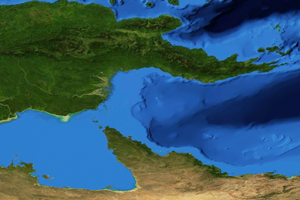
Astrophysicist’s $100M Expedition Uncovers Possible Extraterrestrial Existence Underwater
French astronomer Francois Colas uses a magnifying glass to look at a new meteorite from asteroid 2023 CX1, found in Angiens, northwestern France, on February 17, 2023. An astrophysicist recently discovered an object in Papua New Guinea, identified by scientists as the only known “interstellar” meteorite—meaning that it originated from beyond humanity’s solar system. LOU BENOIST/AFP VIA GETTY IMAGES.
Israeli-American astrophysicist believes that he may have found alien life. The purported discovery took place more than a mile underwater near Papua New Guinea.
Those in search of aliens from other planets would typically look to the stars. But one high-level academic who happens to have a $100 million budget opted to look into the depths of the ocean to uncover what he reported earlier this month may be key discoveries.
Avi Loeb, 61, and author who chaired Harvard University’s astrophysics department from 2011 to 2020, recently led a $1.5 million expedition to research a meteor, dubbed “IM1,” which landed off the coast of Papua New Guinea in 2014.
The object is identified by scientists as the only known “interstellar” meteorite—meaning that it originated from beyond humanity’s solar system.
By the end of Loeb’s days at sea, he and his crew had collected 50 “spherules” from the meteor, which lay more than a mile underwater, using a magnetic, mechanical sled. He described the spherules as tiny balls.
He told the Independent that they looked “beautiful” under a microscope. “One of them looked like Earth,” said Loeb. “Many of them look like gold.”

Loeb thinks that the small spheres, which are from a steel-titanium alloy much stronger than the iron that tends to be found in meteorites, could come from another civilization.
The discovery “felt like a miracle,” he wrote on his blog. He led an expedition to the Pacific Ocean to retrieve spherules of the first recognized interstellar meteor, IM1, and brought back to Harvard College Observatory more than 50 spherules which lay on the deep ocean floor for nearly a decade. “These sub-millimeter-sized spheres, which appear under a microscope as beautiful metallic marbles, were concentrated on the expected path of IM1 — about 85 kilometers (278871.4 feet) off the coast of Manus Island in Papua New Guinea,” said Loeb.
“IM1’s fireball was detected by the US Government on January 8, 2014, and indicated that this meteor was speeding beyond the value required to escape from the Solar system,” he added.
Produced in association with Jewish News Syndicate
Edited by Judy J. Rotich and Newsdesk Manager
“What’s the latest with Florida Man?”
Get news, handpicked just for you, in your box.



